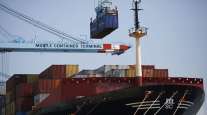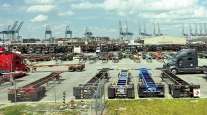Shippers See Opportunities, Limitations In Assessing Intermodal’s Potential
This story appears in the Nov. 28 print edition of Transport Topics. Click here to subscribe today.
ATLANTA — Intermodal transportation is brimming with opportunities, suffering from routing limitations or possibly a mixture of both, industry officials said here.
Those diverse views were expressed by six shippers who spoke Nov. 14 here at a meeting of the Intermodal Association of North America, the Transportation Intermediaries Association and the National Industrial Transportation League.
“There are a significant number of additional [freight] lanes that we are looking at for intermodal,” said Michael Vannatta, director of transportation procurement for LXP, which manages food shipments. “We’d like more coverage for reefer,” Vannatta said.
He told TT that LXP could perhaps double the current 172 lanes where intermodal is used if the service were available.
Gary Palmer, senior director of transportation for hardware chain True Value, agreed.
“We have 13 distribution centers, and there are just eight to 10 corridors where rail serves us effectively,” Palmer said. “We have many other locations where it doesn’t make sense.”
While customers see some limitations, there is no question about intermodal’s continued growth. Domestic shipments are on a record-setting pace this year, rising 6.3% through the third quarter compared with same 2010 period, according to an IANA report. Total intermodal moves rose 5.2% over the same period in 2010 and trail the peak year of 2006 by about 5%.
“We are looking at how to use intermodal to remote stores,” said Wilson Lester, senior vice president supply chain for Rite Aid Stores, which has 4,500 stores nationwide. “I’m really excited about the expansion of intermodal capacity. We will keep looking at it.”
All four largest North American railroads have been touting capacity additions on existing intermodal routes, including public-private initiatives such as CSX’s National Gateway and Norfolk Southern Corp.’s Crescent Corridor.
Union Pacific is spending $300 million to boost capacity on its busiest Chicago-West Coast route. BNSF Railway is working to finish double-tracking of its entire 2,200 mile Chicago-Los Angeles route, spending more than $75 million to add just five miles of track in a New Mexico canyon area.
“Capacity of the network is not a problem,” said Greg Fox, executive vice president of operations at BNSF. He said October freight volumes were still about 10% below the peak of 219,000 shipments on the railroad in late 2006. “I don’t think we will be back to peak volumes until 2013.”
Shippers see other limitations, and opportunities.
“We can only use intermodal on a seasonal basis,” Lester said, to handle merchandise that isn’t time-sensitive.
“Stores have been very reluctant to receive intermodal,” he said, because of slower-than-truck travel times.
“Intermodal is growing more on the West Coast,” said Vic Springer, supply chain director for SP Newsprint Co. “As more lanes are being made available for shipments off the East Coast, we will do more intermodal.”
“We have to be very selective with intermodal,” Springer said, who cited a different limitation for truck/rail moves.
Intermodal providers “talk about intermodal being the same as truck. They have to be able to make it like truck. We haven’t seen that from most of the intermodal providers.”
On the other hand, Mike Cramer, director of logistics and customer operations for Owens Corning, said “the performance of intermodal rail has improved dramatically. I can actually go out to customers and sell it where we could not five or six years ago.”
Along with that positive feature, Cramer cited a drawback.
“I would love to have the ability to put more weight on the trailers,” he said, endorsing the move favored by the trucking industry to raise the 80,000 truck weight limit, which the rail industry opposes. “It is not so much that there is a cost advantage. It’s good to take trucks off the highway.”
Springer also said increased intermodal weight would help, particularly with export shipments.
One shipper saw a unique intermodal opportunity in a comprehensive logistics strategy.
“There is an opportunity for us to leverage intermodal and the intermodal network,” said William Rogers, vice president of operational effectiveness at industrial chemical company Univar USA. “We are working on shaping an overall integrated [logistics] solution.”
Rogers explained that he’s trying to coordinate shipments from 107 individual facilities that arrange transportation independently today.
“We are relying on trucks today,” he said, partly because of difficulty in securing rail tank cars to move hydrochloric acid.
Intermodal carrier officials said they recognize the challenges they face with shippers.
“You’re always comparing yourself to try to be competitive with truck markets,” said Sam Niness, assistant vice president at Thoroughbred Direct Intermodal, a unit of Norfolk Southern. “When you’re trying to sell intermodal you probably have to convince your shipper to switch.”
“The barometer is over-the-road truck,” said Ryan Houfek, assistant vice president of sales at CSX Intermodal. “If we’re trying to use this product to get freight to convert to rail we’ve got to overcome [image problems] and be better than the next guy.”
Staff reporter Eric Miller contributed to this article.




